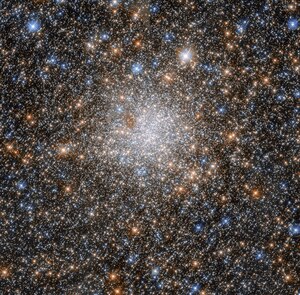NGC 1898
| Kugelsternhaufen NGC 1898 | |
|---|---|
(c) ESA/Hubble, CC BY 4.0 | |
| Zentrum des Sternhaufens NGC 1898, aufgenommen mithilfe des Hubble-Weltraumteleskops | |
| AladinLite | |
| Sternbild | Schwertfisch |
| Position Äquinoktium: J2000.0, Epoche: J2000.0 | |
| Rektaszension | 05h 16m 41,4s [1] |
| Deklination | −69° 39′ 22″ [1] |
| Erscheinungsbild | |
| Helligkeit (visuell) | 11,86 mag [2] |
| Helligkeit (B-Band) | 12,62 mag [2] |
| Winkelausdehnung | 0,8′ |
| Physikalische Daten | |
| Zugehörigkeit | Große Magellansche Wolke |
| Alter | > 13,5 Milliarden Jahre [3] |
| Geschichte | |
| Entdeckung | James Dunlop |
| Entdeckungsdatum | 27. September 1826 |
| Katalogbezeichnungen | |
| NGC 1898 • ESO 56-SC90 • Dun 88 • GC 1106 • OGLE-CL LMC 292, | |
NGC 1898 bezeichnet einen Kugelsternhaufen im Sternbild Schwertfisch. Er hat eine Entfernung von circa 160.000 Lichtjahren und ist Teil der Großen Magellanschen Wolke. Sein Alter beträgt mehr als 13,5 Milliarden Jahre und ähnelt dem der Kugelsternhaufen der Milchstraße.[3]
Man ging lange davon aus, dass der Kugelsternhaufen im Jahr 1834 von dem Astronomen John Herschel mithilfe seines 18,7 Zoll durchmessenden Spiegelteleskops entdeckt und dann später von Johann Dreyer im New General Catalogue verzeichnet wurde. Neuere Untersuchungen zeigen jedoch, dass dieser erstmals von James Dunlop im Jahr 1826 beobachtet wurde, ohne dass man die Identität der Objekte erkannte.[4][5]
Weblinks
Einzelnachweise
- ↑ NASA/IPAC EXTRAGALACTIC DATABASE
- ↑ a b SIMBAD
- ↑ a b K. A. G. Olsen, P. W. Hodge, M. Mateo, E. W. Olszewski, R. A. Schommer, N. B. Suntzeff, A. R. Walker: HSTcolour-magnitude diagrams of six old globular clusters in the LMC. In: Monthly Notices of the Royal Astronomical Society. 300. Jahrgang, Nr. 3, 1998, S. 665–685, doi:10.1046/j.1365-8711.1998.01860.x, bibcode:1998MNRAS.300..665O.
- ↑ Seligman
- ↑ Glendyn John Cozens: An analysis of the first three catalogues of southern star clusters and nebulae. PhD thesis, James Cook University, 2008.
Auf dieser Seite verwendete Medien
(c) ESA/Hubble, CC BY 4.0
Celestial fairy lights
This glittering ball of stars is the globular cluster NGC 1898, which lies towards the centre of the Large Magellanic Cloud — one of our closest cosmic neighbours. The Large Magellanic Cloud is a dwarf galaxy that hosts an extremely rich population of star clusters, making it an ideal laboratory for investigating star formation.
Discovered in November 1834 by British astronomer John Herschel, NGC 1898 has been scrutinised numerous times by the NASA/ESA Hubble Space Telescope. Today we know that globular clusters belong to the oldest known objects in the Universe and that they are relics of the first epochs of galaxy formation. While we already have a pretty good picture on the globular clusters of the Milky Way — still with many unanswered questions — our studies on globular clusters in nearby dwarf galaxies just started. The observations of NGC 1898 will help to determine if their properties are similar to the ones found in the Milky Way, or if they have different features, due to being in a different cosmic environment.
This image was taken by Hubble’s Advanced Camera for Surveys (ACS) and Wide Field Camera 3 (WFC3). The WFC3 observes light ranging from near-infrared to near-ultraviolet wavelengths, while the ACS explores the near-infrared to the ultraviolet.
Credit:
ESA/Hubble & NASA
Coordinates Position (RA): 5 16 43.07 Position (Dec): -69° 39' 23.27" Field of view: 1.92 x 1.89 arcminutes Orientation: North is 104.7° left of vertical
Colours & filters Band Wavelength Telescope Optical B 438 nm Hubble Space Telescope WFC3 Ultraviolet B 336 nm Hubble Space Telescope WFC3 Optical B 475 nm Hubble Space Telescope ACS Infrared I 814 nm Hubble Space Telescope ACS.

